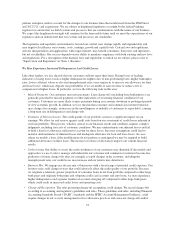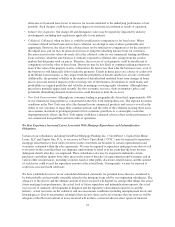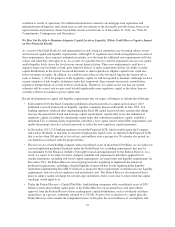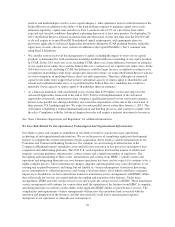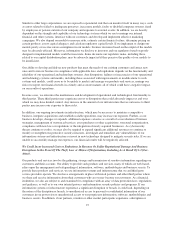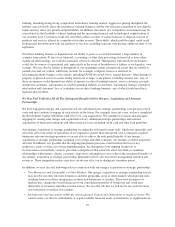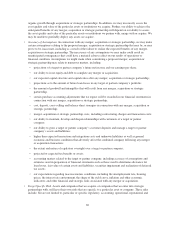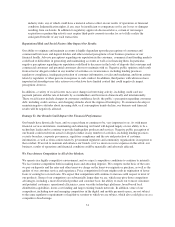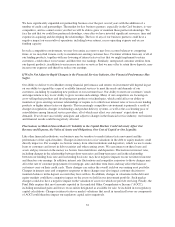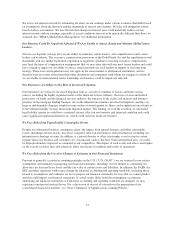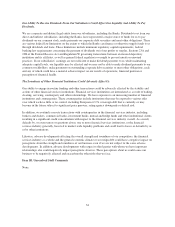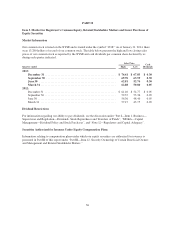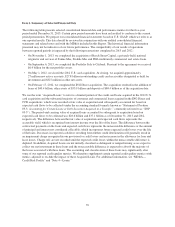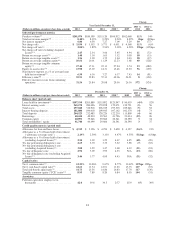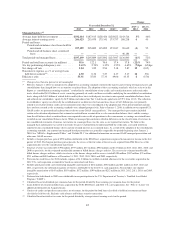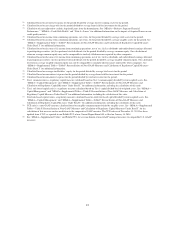Capital One 2013 Annual Report Download - page 53
Download and view the complete annual report
Please find page 53 of the 2013 Capital One annual report below. You can navigate through the pages in the report by either clicking on the pages listed below, or by using the keyword search tool below to find specific information within the annual report.We assess our interest rate risk by estimating the effect on our earnings under various scenarios that differ based
on assumptions about the direction and the magnitude of interest rate changes. We take risk mitigation actions
based on those assessments. We face the risk that changes in interest rates could materially reduce our net
interest income and our earnings, especially if actual conditions turn out to be materially different than those we
assumed. See “MD&A-Market Risk Management” for additional information.
Our Business Could Be Negatively Affected If We Are Unable to Attract, Retain and Motivate Skilled Senior
Leaders.
Our success depends, in large part, on our ability to retain key senior leaders, and competition for such senior
leaders can be intense. The executive compensation provisions of the Dodd-Frank Act and the regulations issued
thereunder, and any further legislation, regulation or regulatory guidance restricting executive compensation,
may limit the types of compensation arrangements that we may enter into with our most senior leaders and could
have a negative impact on our ability to attract, retain and motivate such leaders in support of our long-term
strategy. These laws and regulations may not apply in the same manner to all financial institutions, and we
therefore may face more restrictions than other institutions and companies with whom we compete for talent. If
we are unable to retain talented senior leadership, our business could be negatively affected.
Our Businesses are Subject to the Risk of Increased Litigation.
Our businesses are subject to increased litigation risks as a result of a number of factors and from various
sources, including the highly regulated nature of the financial services industry, the focus of state and federal
prosecutors on banks and the financial services industry, the structure of the credit card industry and business
practices in the mortgage lending business. Given the inherent uncertainties involved in litigation, and the very
large or indeterminate damages sought in some matters asserted against us, there can be significant uncertainty as
to the ultimate liability we may incur from litigation matters. The finding, or even the assertion, of substantial
legal liability against us could have a material adverse effect on our business and financial condition and could
cause significant reputational harm to us, which could seriously harm our business.
We Face Risks from Unpredictable Catastrophic Events.
Despite our substantial business contingency plans, the impact from natural disasters and other catastrophic
events, including terrorist attacks, may have a negative effect on our business and infrastructure, including our
information technology systems. In addition, if a natural disaster or other catastrophic event occurs in certain
regions where our business and customers are concentrated, such as the New York metropolitan area, we could
be disproportionately impacted as compared to our competitors. The impact of such events and other catastrophes
on the overall economy may also adversely affect our financial condition and results of operations.
We Face Risks from the Use of or Changes to Estimates in Our Financial Statements.
Pursuant to generally accepted accounting principles in the U.S. (“U.S. GAAP”), we are required to use certain
assumptions and estimates in preparing our financial statements, including, but not limited to, estimating our
allowance for loan and lease losses and the fair value of certain assets and liabilities. In addition, the FASB, the
SEC and other regulatory bodies may change the financial accounting and reporting standards, including those
related to assumptions and estimates we use to prepare our financial statements, in ways that we cannot predict
and that could impact our financial statements. If actual results differ from the assumptions or estimates
underlying our financial statements or if financial accounting and reporting standards are changed, we may
experience unexpected material losses. For a discussion of our use of estimates in the preparation of our
consolidated financial statements, see “Note 1-Summary of Significant Accounting Policies.”
33


